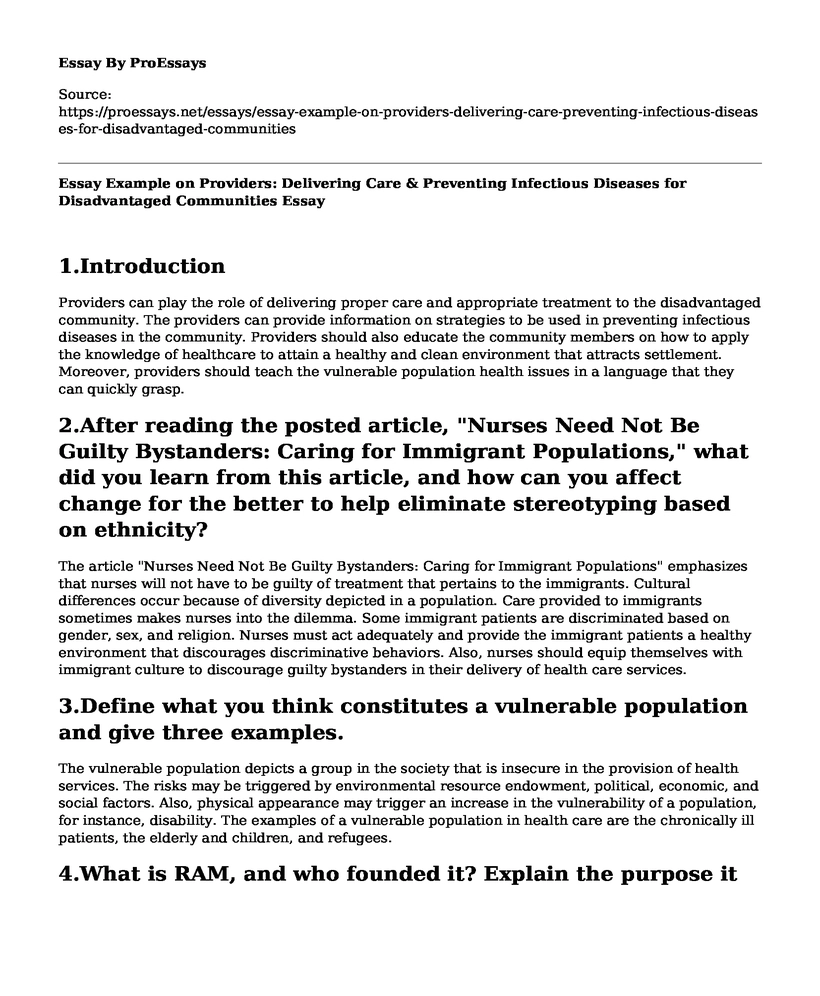1.Introduction
Providers can play the role of delivering proper care and appropriate treatment to the disadvantaged community. The providers can provide information on strategies to be used in preventing infectious diseases in the community. Providers should also educate the community members on how to apply the knowledge of healthcare to attain a healthy and clean environment that attracts settlement. Moreover, providers should teach the vulnerable population health issues in a language that they can quickly grasp.
2.After reading the posted article, "Nurses Need Not Be Guilty Bystanders: Caring for Immigrant Populations," what did you learn from this article, and how can you affect change for the better to help eliminate stereotyping based on ethnicity?
The article "Nurses Need Not Be Guilty Bystanders: Caring for Immigrant Populations" emphasizes that nurses will not have to be guilty of treatment that pertains to the immigrants. Cultural differences occur because of diversity depicted in a population. Care provided to immigrants sometimes makes nurses into the dilemma. Some immigrant patients are discriminated based on gender, sex, and religion. Nurses must act adequately and provide the immigrant patients a healthy environment that discourages discriminative behaviors. Also, nurses should equip themselves with immigrant culture to discourage guilty bystanders in their delivery of health care services.
3.Define what you think constitutes a vulnerable population and give three examples.
The vulnerable population depicts a group in the society that is insecure in the provision of health services. The risks may be triggered by environmental resource endowment, political, economic, and social factors. Also, physical appearance may trigger an increase in the vulnerability of a population, for instance, disability. The examples of a vulnerable population in health care are the chronically ill patients, the elderly and children, and refugees.
4.What is RAM, and who founded it? Explain the purpose it serves and the population.
RAM (Remote Area Mobile) is a non-profit mobile medical clinic provider that offers medical care, vision, and free dental care to uninsured persons and under-serves in the community. Stan Block, a British Philanthropist, founded RAM.
5.Does Medicaid provide dental and vision care for adults? What impact does this have on that population and health outcomes?
Medicaid provides dental and vision care to adults. Medicaid covers costs in providing adult implants to replace permanent teeth. Medicaid has expanded access to treatment, which has lowered the probability of delayed treatment. The Medicaid services have seen a decline in mortality rates in New York, Maine, and Arizona.
6.In the article Development of a Community Nurse-Managed Health center, there are three goals listed in establishing the clinic. What are they?
The three goals are disease prevention services, health promotion, and provision of primary health care to the vulnerable population in the community.
7.How do you think low literacy impacts a person's ability to seek health care? What are the long-range health problems that can develop without preventive health care?
Higher literacy in the society will ensure the effective creation of awareness on preventive health services, for instance, vaccines. On the other hand, low literacy affects a patient's interpretation of drug guidance provided by the physicians. The long-range health problems that develop without preventive healthcare are high blood pressure, asthma, and diabetes.
8.In the video on government and health care, there is some discussion about 3rd party purchases related to health care. What does this mean?
3rd party purchases related to healthcare refers to anyone that pays for medical services rather than the patient. 3rd party purchases are derived from Medicaid, Medicare, and Commercial Insurance.
9.In the RAM videos, what is the greatest need that people seek care for, and what could help solve this problem?
People seek care mainly due to mental health problems. The solution to the problem is integrating into primary healthcare that is affordable and easy to access by the vulnerable population in the community.
10.After watching the video on the Affordable Care Act, what do you think are positives and negatives of the Act?
Positive impacts of the Affordable Care Act:
- Increase in the number of Americans having insurance cover.
- Provision of affordable healthcare to many Americans
- Patients with preexisting health conditions, for instance, Cancer has health cover.
- Low cost of prescription drugs.
Negative impacts of the Affordable Care Act:
- Tax penalties if you do not have insurance cover
- A higher population has to pay higher premiums.
- A complication in shopping for coverage
11.For extra credit, tell me what you think is wrong with our health care system and what could be done to fix it?
The high cost of health care is triggered by much of U.S health insurance being private and reliance on free for service insurance cover by the country. The condition has seen an increase in the number of patients flogging the health facilities, even with minor health conditions. The government can resolve the issue by increasing door to door minor patient treatment to reduce congestions in the hospital.
Cite this page
Essay Example on Providers: Delivering Care & Preventing Infectious Diseases for Disadvantaged Communities. (2023, Aug 28). Retrieved from https://proessays.net/essays/essay-example-on-providers-delivering-care-preventing-infectious-diseases-for-disadvantaged-communities
If you are the original author of this essay and no longer wish to have it published on the ProEssays website, please click below to request its removal:
- Ethical Standards to Obtain Ethics Approval
- King`s Conceptual System Theory Essay Example
- Questions and Answers Essay on Nursing and Drugs
- A) What effect is Anzaldua showing readers of mixing English and Spanish?
- Acquired Immunodeficiency Syndrome (AIDS) Paper Example
- High Prevalence of Kidney Stones in Asian Jews: Essay Sample
- Nurses' Ethical, Legal & Professional Duties: A Guide - Essay Sample







